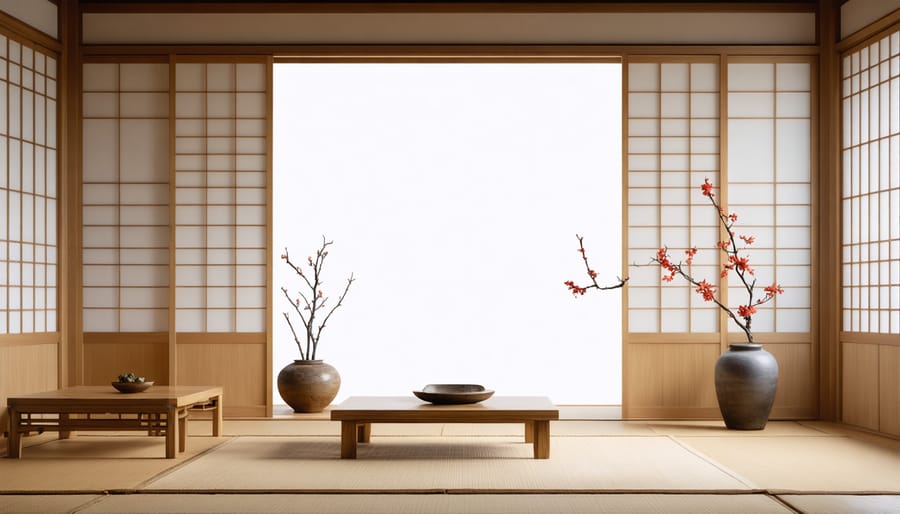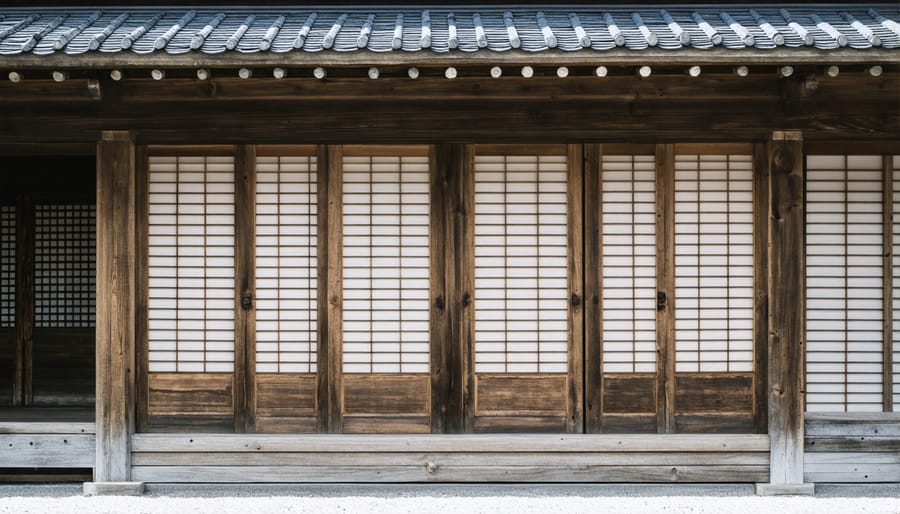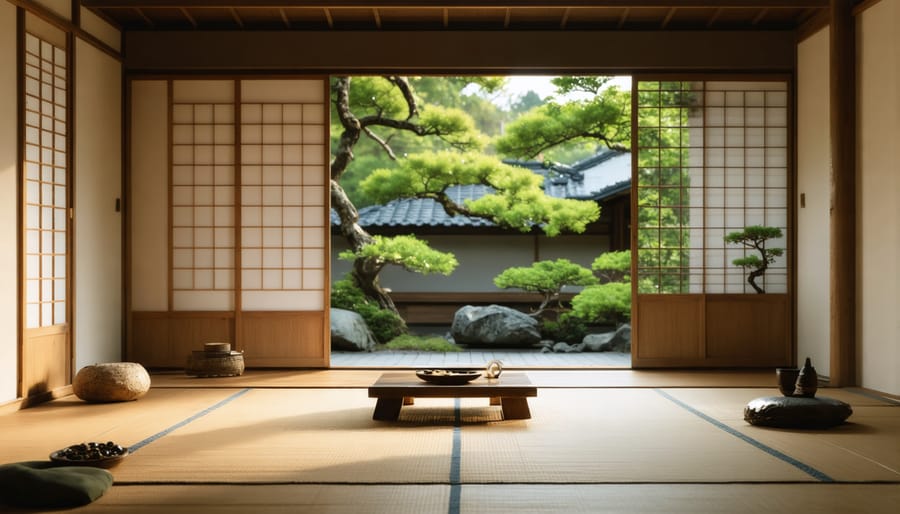
Transform Your Home with Japanese Minimalist Design (Without Living Like a Monk)
Transform your living space into a serene sanctuary by embracing the timeless principles of Japanese minimalist design. This sophisticated approach to minimalist design styles combines clean lines, natural materials, and purposeful simplicity to create spaces that feel both contemporary and deeply rooted in tradition. Strip away unnecessary decorative elements, focusing instead on essential pieces that serve both function and form. Select furniture with low profiles and simple geometries, positioning each piece thoughtfully to maintain open pathways and clear sight lines throughout your space. Natural light becomes a crucial design element, filtered through shoji screens or minimal window treatments to create dynamic shadows that change throughout the day. This harmonious blend of restraint and functionality doesn’t just declutter your home—it transforms it into a peaceful retreat that honors the Japanese principles of ma (negative space) and wabi-sabi (finding beauty in imperfection).
Core Elements of Japanese Minimalist Design
Ma (Negative Space)
Ma, or negative space, is a fundamental principle in Japanese design that embraces the beauty of emptiness. Unlike Western design, which often seeks to fill spaces, Ma celebrates the purposeful absence of objects, creating room for contemplation and visual rest.
To implement Ma in your home, start by clearing unnecessary items from your spaces. Rather than viewing empty corners or bare walls as areas that need filling, appreciate them as intentional design elements that bring balance and tranquility. A simple alcove with a single artwork or ikebana arrangement becomes more impactful when surrounded by emptiness.
Consider leaving at least 30% of your room empty, allowing energy to flow freely. This might mean having fewer furniture pieces, maintaining clear pathways, and resisting the urge to decorate every surface. The space between objects is just as important as the objects themselves.
When arranging furniture, create meaningful pauses between pieces. These thoughtful gaps help define zones within a room while maintaining an open, harmonious atmosphere. Remember, Ma isn’t about creating stark or cold spaces – it’s about finding the perfect balance between presence and absence.
Natural Materials and Textures
Natural materials form the foundation of Japanese minimalist design, creating a harmonious connection between indoor spaces and nature. Traditional elements like wood, bamboo, and stone take center stage, with unfinished or lightly treated surfaces that showcase their authentic textures and patterns.
Choose light-colored woods like hinoki cypress or maple for flooring and furniture, as these materials bring warmth while maintaining the bright, airy feel essential to minimalist spaces. Consider incorporating tatami mats, made from woven rush grass, which add both visual texture and cultural authenticity to your room.
Raw concrete, when used sparingly, can provide an interesting contrast to natural wood elements while maintaining the minimalist aesthetic. Natural fiber textiles like cotton, linen, and silk work beautifully for curtains and upholstery, offering subtle texture without overwhelming visual interest.
For wall treatments, consider shoji screens with washi paper or clay-based finishes that create depth through their subtle imperfections. Stone elements, particularly in bathrooms or entryways, should be chosen in neutral tones with natural variations in pattern and texture.
Remember that each material should serve a purpose while contributing to the overall sense of calm and simplicity in your space.

Creating Your Japanese Minimalist Space
Color Palettes and Lighting
In Japanese minimalist design, creating a cohesive color scheme starts with embracing earth tones and neutral colors. Think warm whites, soft beiges, and gentle grays as your base palette. These colors create a sense of calm while reflecting natural light throughout your space.
For accent colors, look to nature for inspiration. Soft sage greens, warm browns, and muted slate blues can add subtle depth without overwhelming the minimalist aesthetic. Limit yourself to 2-3 accent colors maximum to maintain simplicity and visual harmony.
Lighting plays a crucial role in Japanese minimalist spaces. Maximize natural light by keeping windows unobstructed and using sheer window coverings. Traditional Japanese homes often incorporate paper screens (shoji) to diffuse natural light – you can achieve a similar effect with frosted glass or translucent curtains.
For artificial lighting, opt for warm-toned LED fixtures that mimic natural light. Layer your lighting with a combination of:
– Ceiling-mounted fixtures for ambient lighting
– Floor lamps with paper or fabric shades for soft illumination
– Small accent lights to highlight architectural features or art pieces
Remember to position lights at different heights to create depth and eliminate harsh shadows. This thoughtful approach to lighting and color helps create the serene, balanced atmosphere that’s quintessential to Japanese minimalist design.
Furniture Selection and Placement
In Japanese minimalist design, furniture selection follows the “less is more” principle, focusing on pieces that serve both functional and aesthetic purposes. Choose low-profile furniture with clean lines and natural materials like wood, bamboo, or rattan. A platform bed, low dining table (chabudai), and floor cushions (zabuton) are quintessential elements that create an authentic Japanese atmosphere while maintaining minimalist simplicity.
When selecting furniture, prioritize pieces with dual functionality. Consider storage ottomans, folding screens that double as room dividers, and built-in storage solutions that keep spaces clutter-free. Stick to a neutral color palette with natural wood tones to maintain visual harmony.
Furniture placement should follow the principle of ma (negative space), allowing room for movement and energy flow. Position larger pieces against walls, leaving the center of rooms open. This creates a sense of spaciousness and promotes easy navigation through the space. Maintain balanced proportions by keeping furniture heights consistent and avoiding tall pieces that might overwhelm the room.
Consider the viewing angles and sight lines when arranging furniture. Each piece should have a clear purpose and relationship to the space around it. Keep at least 3 feet of walking space between furniture pieces, and arrange seating to promote conversation while maintaining a serene atmosphere. Remember that in Japanese design, every item should earn its place through both functionality and aesthetic contribution to the space.
Storage Solutions
In Japanese minimalist design, clever storage solutions are essential for maintaining clean, uncluttered spaces while keeping everyday items within reach. Traditional Japanese homes make excellent use of built-in storage, and you can adopt these principles in your modern space.
Consider installing floor-to-ceiling sliding doors (fusuma) that conceal storage areas. These sleek panels maintain visual harmony while hiding closet spaces, shelving, or even entire rooms. For smaller spaces, opt for multi-functional furniture like platform beds with built-in drawers or low-profile cabinets that double as room dividers.
Take inspiration from traditional tansu cabinets by incorporating step-style storage units that can fit under stairs or in awkward corners. These modular pieces offer both functionality and visual interest without overwhelming the space. Wall-mounted storage solutions, such as floating shelves in natural wood tones, provide necessary storage while maintaining the minimalist aesthetic.
Make use of vertical space with tall, narrow cabinets that maximize storage capacity while minimizing floor space usage. Traditional bamboo baskets and boxes can be used inside closets and drawers to keep items organized and maintain the Japanese aesthetic even in hidden spaces.
Remember to keep stored items to a minimum, following the principle of ‘less is more.’ Regular decluttering sessions help maintain the serene atmosphere that defines Japanese minimalist interiors. Choose storage solutions in natural materials and neutral colors to blend seamlessly with your overall design scheme.
Room-by-Room Implementation
Living Room Essentials
In a Japanese minimalist living room, less truly becomes more. Start with a low-profile sofa in neutral tones like beige, gray, or white, preferably with clean lines and minimal ornamentation. A simple low wooden coffee table, ideally crafted from light-colored wood like maple or hinoki cypress, serves as both a functional piece and visual anchor.
Floor cushions (zabuton) offer flexible seating options while maintaining authenticity. Incorporate natural elements through potted bamboo or a single ikebana arrangement, creating a subtle focal point without overwhelming the space. Storage solutions should be concealed behind sliding panels or tucked away in built-in cabinets to maintain the clutter-free aesthetic.
Lighting plays a crucial role – opt for paper lanterns or minimalist pendant lights that cast soft, diffused illumination. Window treatments should be simple and natural, like bamboo blinds or sheer white curtains that filter natural light. Keep wall decorations minimal; a single scroll painting or black-and-white photograph can make a powerful statement.
Complete the space with a natural fiber rug in muted tones, creating warmth while maintaining the room’s serene atmosphere.


Bedroom Tranquility
In Japanese minimalist design, the bedroom serves as a sanctuary of peace and simplicity. Traditional Japanese beds and futons placed low to the ground create an authentic foundation while promoting better airflow and a grounding connection to the space. Keep furniture minimal, typically limiting pieces to essential storage and perhaps a small side table for practical needs.
Choose natural materials and soft, muted colors that promote relaxation – think warm woods, bamboo elements, and neutral textiles. A single piece of calming artwork or a carefully placed ikebana arrangement can serve as a focal point without disturbing the room’s tranquility.
Storage should be concealed behind clean-lined closet doors or within minimal furniture pieces to maintain visual calm. Opt for natural fiber bedding in solid colors, and consider light-filtering shoji-style screens for windows to create that characteristic soft, diffused lighting that Japanese interiors are known for.
Remember, the goal is to create a space that allows your mind to rest undistracted, promoting better sleep and morning clarity.
Kitchen and Bathroom Simplicity
In Japanese minimalist design, kitchens and bathrooms embrace functionality without sacrificing style. These high-traffic spaces benefit from clean lines and clutter-free surfaces, making them both practical and peaceful. Modern white kitchen designs particularly complement this aesthetic, creating bright, open spaces that feel larger and more inviting.
For kitchens, consider installing built-in storage solutions that keep appliances and utensils hidden when not in use. Opt for handleless cabinets and drawers for a seamless look, and choose materials like light wood or matte finishes that create visual harmony. A simple backsplash in neutral tones maintains the peaceful atmosphere while being easy to clean.
In bathrooms, wall-mounted vanities and toilets create an illusion of more floor space while making cleaning easier. Storage should be minimal but strategic – think built-in niches for toiletries and simple wooden organizers for daily essentials. Natural elements like bamboo mats or stone-like tiles can add warmth without compromising the minimalist aesthetic. The key is to maintain open space while ensuring everything serves a purpose.
Maintenance and Lifestyle Tips
Maintaining a Japanese minimalist interior requires both mindful habits and regular care. Start by adopting the “one in, one out” rule – whenever you bring a new item home, remove something else to maintain balance. This practice helps prevent clutter accumulation and keeps your space serene.
Create daily rituals around tidying up, such as putting items away immediately after use and wiping surfaces clean each evening. These small habits contribute significantly to maintaining the clean, uncluttered aesthetic characteristic of Japanese minimalism.
Consider implementing a seasonal cleaning schedule, aligned with the Japanese tradition of thorough house cleaning before major festivals. This includes dusting natural elements like bamboo screens and wooden furniture, cleaning tatami mats if you have them, and reorganizing storage spaces.
For textile maintenance, regularly air out cushions and throws, and clean or replace paper screens (shoji) as needed. Keep wood surfaces in good condition by using appropriate cleaning products and avoiding excess moisture.
Remember that Japanese minimalism isn’t just about aesthetics – it’s a lifestyle choice that promotes mindfulness and intentionality. Take time each month to evaluate your space and possessions, asking yourself if each item truly serves a purpose or brings joy. This regular reflection helps maintain not just the physical appearance of your minimalist space, but also its spiritual essence.
When decorating seasonally, choose one or two subtle elements rather than elaborate displays. This maintains the minimalist aesthetic while acknowledging the changing seasons, a crucial aspect of Japanese design philosophy.
Japanese minimalist interior design offers a timeless approach to creating serene, functional living spaces that can transform your home into a peaceful sanctuary. By embracing the core principles of simplicity, natural elements, and purposeful design, you can achieve a space that not only looks beautiful but also promotes mental clarity and emotional well-being.
Remember that your journey toward minimalism doesn’t have to happen overnight. Start small by decluttering one room at a time, incorporating natural materials, and being mindful of the items you choose to keep and display. Focus on quality over quantity, and let each piece in your space serve a purpose or bring genuine joy.
The beauty of Japanese minimalist design lies in its flexibility – you can adapt these principles to suit your lifestyle while maintaining their essence. Whether you live in a compact apartment or a spacious house, these design concepts can help you create a more balanced, harmonious living environment.
Take the first step today by selecting one area of your home to transform. As you progress, you’ll likely find that less truly can be more, leading to a more organized, peaceful, and intentional way of living.
